Related Research Articles

Lake Michigan is one of the five Great Lakes of North America. It is the second-largest of the Great Lakes by volume and the third-largest by surface area, after Lake Superior and Lake Huron. To the east, its basin is conjoined with that of Lake Huron through the 3+1⁄2-mile (5.6-kilometer) wide, 295-foot deep Straits of Mackinac, giving it the same surface elevation as its easterly counterpart; geologically, the two bodies are a single lake that is, by area, the largest freshwater lake in the world.
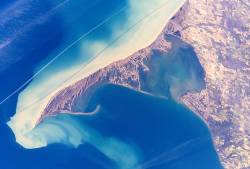
Long Point is a sand spit and medium-sized hamlet on the north shore of Lake Erie, part of Norfolk County in the province of Ontario, Canada.
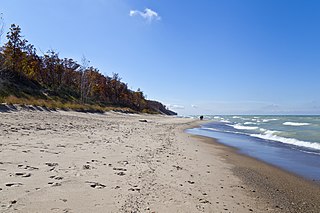
Indiana Dunes National Park is a United States national park located in northwestern Indiana managed by the National Park Service. It was authorized by Congress in 1966 as the Indiana Dunes National Lakeshore and was redesignated as the nation's 61st national park on February 15, 2019. The park runs for about 20 miles (32 km) along the southern shore of Lake Michigan and covers 15,349 acres (6,212 ha). Along the lakefront, the eastern area is roughly the lake shore south to U.S. 12 or U.S. 20 between Michigan City, Indiana, on the east and the Cleveland-Cliffs steel plant on the west. This area's conservation scheme is enhanced by the older Indiana Dunes State Park. To the west of the steel plant lies West Beach and a small extension south of the steel mill continues west along Salt Creek to Indiana 249. The western area is roughly the shoreline south to U.S. 12 between the Burns Ditch west to Broadway in downtown Gary, Indiana. In addition, there are several outlying areas, including Pinhook Bog, in LaPorte County to the east; the Heron Rookery in Porter County, the center of the park; and the Hoosier Prairie State Nature Preserve and the Hobart Prairie Grove, both in Lake County, the western end of the park.

Sleeping Bear Dunes National Lakeshore is a U.S. national lakeshore in the northwestern Lower Peninsula of Michigan. Located within Benzie and Leelanau counties, the park extends along a 35-mile (56 km) stretch of Lake Michigan's eastern coastline, as well as North and South Manitou islands, preserving a total of 71,199 acres. The park is known for its outstanding natural features, including dune formations, forests, beaches, and ancient glacial phenomena. The lakeshore also contains many cultural features, including the 1871 South Manitou Island Lighthouse, three former stations of the Coast Guard, and an extensive rural historic farm district.

Indiana Dunes State Park is an Indiana State Park located in Porter County, Indiana, United States, 47 miles (75.6 km) east of Chicago. The park is bounded by Lake Michigan to the northwest and is surrounded by as well as within the authorized boundaries of Indiana Dunes National Park, a unit of the National Park Service; the NPS owns the water from the ordinary high water mark to 300 feet (91 m) offshore. The 1,530-acre (619.2 ha) Dunes Nature Preserve makes up the bulk of eastern part of the park, and includes most of the park's hiking trails and dune landscape. This was one of the first places Richard Lieber considered when establishing the Indiana State Park system. Like all Indiana state parks, there is a fee for entrance. Indiana Dunes State Park was established in 1925 and designated a National Natural Landmark in 1974.
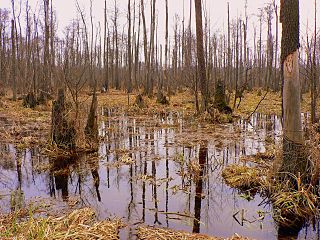
Kampinos National Park is a national park in east-central Poland, in Masovian Voivodeship, on the northwest outskirts of Warsaw. It is Poland's second-largest national park by area and the only national park in the Masovian Voivodeship. It has a sister park agreement with Indiana Dunes National Park, Indiana, United States.

Cowles Bog is a 4,000-year-old wetland complex in Indiana Dunes National Park, near Chesterton, Indiana. It is named for Henry Chandler Cowles who did his pioneering work in ecology and ecological succession here. His work brought international attention to the area which led to efforts to preserve the Indiana Dunes. It was designated a National Natural Landmark in 1965. It contains bog, fen, marsh, wet meadow, swamp, and pond habitats.
Leila (Lee) Botts was an American environmentalist known primarily for her work related to conservation and restoration of the Great Lakes. She founded two non-profit organizations, directed a subagency of the U.S. Department of the Interior in the administration of President Jimmy Carter, authored or co-authored a number of books and reports on environmental issues, served in the administration of the late Chicago Mayor Harold Washington, and co-produced a documentary film called Shifting Sands: On the Path to Sustainability, on the history of the Indiana Dunes region.

Miller Beach is a neighborhood of Gary, Indiana on the southernmost shore of Lake Michigan. First settled in 1851, Miller Beach was originally an independent town. However, the "Town of Miller" was eventually annexed by the then flourishing city of Gary in 1918. Located in the northeastern corner of Lake County, Indiana, the former town is now known as "The Miller Beach Community." Miller Beach borders Lake Michigan to the north, Porter County to the east, and is largely surrounded by protected lands, including Indiana Dunes National Park. Miller Beach is also the closest beach/resort community to Chicago, and has been a popular vacation spot since the early 20th century. As of the 2000 US census, it had a population of 9,900.

The Florida Tropical House is a beach house located on Lake Michigan's shoreline in Beverly Shores, Indiana, US. It was built in 1933 as part of the Homes of Tomorrow Exhibition at the 1933 World's Fair in nearby Chicago. Today it is part of the Century of Progress Architectural District, a historic district.
The Indiana Dunes are natural sand dunes occurring at the southern end of Lake Michigan in the American State of Indiana. They are known for their ecological significance. Many conservationists have played a role in preserving parts of the Indiana Dunes. The Hour Glass, a museum in Ogden Dunes, showcases some of the ecological import of the Dunes.

The Indiana Dunes comprise ten different habitats. Each provides for a unique combination of plants and animals. The range of the Indiana Dunes varies depending your source. The Indiana Lake Michigan Coastal Program uses the river drainage systems along the shoreline. This expands the area from the areas of lakeshore southward to the edges of the Valparaiso Moraine. This entire region has been dune landscapes since over 114,000 years before present (YBP). Traditionally, the Indiana Dunes area thought of as a narrow area along the shores of Lake Michigan, including the areas of Marquette Park in Gary, Indiana (1920), Indiana Dunes State Park (1926) and Indiana Dunes National Park,. The identified ten habitats can be found in these parks, where they have been preserved, but are also visible throughout the three counties of Northwest Indiana.

Baillytown is a former community in northern Porter County, Indiana, near the present-day communities of Porter and Burns Harbor. Although the town platted as the Town of Bailly was never built, the Baillytown name was used for many years to refer to the area around the original Joseph Bailly trading post. The name continues today as the name of a subdivision, constructed in the 1990s, in the town of Porter.
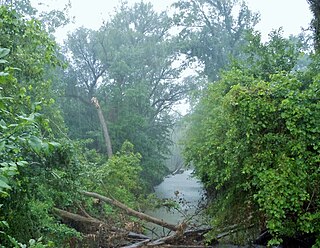
The East Arm Little Calumet River, also known as the Little Calumet River East Branch, is a 22.1-mile-long (35.6 km) portion of the Little Calumet River that begins just east of Holmesville, Indiana in New Durham Township in LaPorte County and flows west to Porter County and the Port of Indiana-Burns Waterway.

Salt Creek is a 24.0-mile-long (38.6 km) tributary of the East Arm Little Calumet River that begins south of Valparaiso in Porter County, Indiana and flows north until it joins the East Arm Little Calumet River just before it exits to Lake Michigan via the Port of Indiana-Burns Waterway.
Hazel Hannell was an American artist and activist. She was known for her pottery, watercolors, woodblock prints, activism for the Indiana Dunes National Lakeshore and development of the Chesterton Arts Fair. She taught pottery in her studio at home and watercolor painting at The Clearing Folk School in Ellison Bay, Wisconsin through her connection to fellow Prairie Club member Jens Jensen. She died in Ashland, Oregon while living with Harriet Rex Smith at age 106.
Dorothy Richardson Buell (1886–1976) was an American educator and nature preservationist who became the founder and first president of the Save the Dunes Council, a nonprofit group dedicated to preserving the Indiana dunelands along Lake Michigan. Buell led a grassroots effort to save the remaining unspoiled dunes in northwestern Indiana from industrial development. Buell's sixteen-year leadership of the Save the Dunes Council, from 1952 to 1968, preserved thousands of acres of dunelands at the Indiana Dunes National Lakeshore, which she helped to establish in 1966 as an urban park as part of the National Park Service.
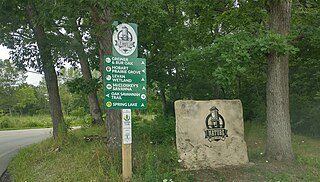
The Hobart Nature District is located in the City of Hobart, Indiana and includes over 1,000 acres (400 ha) of scenic parks, wetlands and floodplains, winding rivers, peaceful lakes, open prairies, oak savannas, old-growth forests, and undulating ravines.
References
- ↑ "Home Page". Save the Dunes. Retrieved 2023-12-31.
- ↑ Grenberg, Joel (2002). A natural History of the Chicago Region. p. 266. ISBN 0-226-30649-6.
- ↑ Engel, J. Ronald (1983). Sared Sands, the struggle for communityi n the Indiana Dunes. pp. 253–289. ISBN 0-8195-6129-0.
- ↑ Franklin, Kay (1983). Duel for the Dunes. ISBN 0-252-01034-5.
- ↑ "Indiana finally has its first national park". Indianapolis Star. Retrieved 2019-04-27.
- ↑ "Living in the Dunes". ILASLA. Retrieved 2019-04-27.
- ↑ Robinson, Tia (September 10, 2022). "Celebrate the Monarch butterflies' migration with Save the Dunes". ABC57.